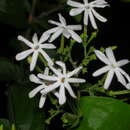pt-BR
nomes no trilho de navegação


जुई हे एक फुलझाड आहे. या वनस्पतीचे शास्त्रीय नाव जस्मिनम ऑरिक्युलेटम [Jasminum auriculatum] असे आहे. जुईला संस्कृतमध्ये गणिका, अम्बष्ठा , मुग्धी अशी नावे आहेत. हिला इंग्रजीत Needle Flower Jasmine म्हणतात.
জুহি ফুল (বৈজ্ঞানিক নাম: Jasminum auriculatum) হৈছে অ’লেচিয়া পৰিয়ালৰ অন্তৰ্গত জেছ্মিনৰ এটা প্ৰজাতি। ইয়াক ভাৰত, নেপাল, শ্ৰীলংকা, ভুটান আৰু আন্দামান দ্বীপপুঞ্জত পোৱা যায়।[1][2] ইয়াৰ ফুলত থকা অতি দৰকাৰী তেলৰ বাবে ভাৰত আৰু থাইলেণ্ডত ইয়াৰ ব্যৱসায়িকভাৱে কৃষি কৰা হয়। ভাৰতত ইয়াক সৌন্দৰ্য বৰ্দ্ধন আৰু উৎসৱত ব্যৱহাৰ কৰা হয়। বঙালী ভাষাত ইয়াক "জুই" (JUI) বুলি কোৱা হয়।[3]
'জেছ্মিনাম (Jasminum)' শব্দটো আৰবি শব্দ ‘য়াছমিন (yasemin)’ শব্দৰ লেটিন ৰূপ, যাৰ অৰ্থ হৈছে মিঠা গন্ধযুক্ত উদ্ভিদ।[4]
জুহি ফুল (বৈজ্ঞানিক নাম: Jasminum auriculatum) হৈছে অ’লেচিয়া পৰিয়ালৰ অন্তৰ্গত জেছ্মিনৰ এটা প্ৰজাতি। ইয়াক ভাৰত, নেপাল, শ্ৰীলংকা, ভুটান আৰু আন্দামান দ্বীপপুঞ্জত পোৱা যায়। ইয়াৰ ফুলত থকা অতি দৰকাৰী তেলৰ বাবে ভাৰত আৰু থাইলেণ্ডত ইয়াৰ ব্যৱসায়িকভাৱে কৃষি কৰা হয়। ভাৰতত ইয়াক সৌন্দৰ্য বৰ্দ্ধন আৰু উৎসৱত ব্যৱহাৰ কৰা হয়। বঙালী ভাষাত ইয়াক "জুই" (JUI) বুলি কোৱা হয়।
ଯୁଇ ଗଛ (ଉଦ୍ଭିଦ ବିଜ୍ଞାନ ନାମ - Jasminum auriculatum[୧]) ମଲ୍ଲୀ ବଂଶର ଏକ ପ୍ରଜାତି ଅଟେ । ଏହା ଭାରତ, ନେପାଳ, ଶ୍ରୀଲଙ୍କା, ଭୁଟାନ ଏବଂ ଆଣ୍ଡାମାନ ଦ୍ୱୀପପୁଞ୍ଜରେ ଦେଖିବାକୁ ମିଳେ [୨]। | ଏହା ଭାରତରେ ସାଜସଜ୍ଜା ଉଦ୍ଦେଶ୍ୟ ଏବଂ ପର୍ବପର୍ବାଣୀରେ ବ୍ୟବହୃତ ହୁଏ । ଏହା ଗୋଟିଏ ସବୁଦିନିଆ ବା ବାରମାସୀ ଗୁଳ୍ମ ଜାତୀୟ ବୃକ୍ଷ ଅଟେ ।
ଯୁଇ ସାରା ଭାରତରେ ବହୁଳ ଭାବରେ ଦେଖାଯାଏ । ବିଭିନ୍ନ ଭାରତୀୟ ଭାଷାରେ ଏହାର ନାମ ଏହିପରି :-
ଭାରତୀୟ ପାରମ୍ପରିକ ଔଷଧ ପ୍ରଣାଳୀରେ ଯୁଇ ଗଛର ପତ୍ର ପାଟିରେ ହେଉଥିବା ଘାଗୁଡିକର ଚିକିତ୍ସାରେ ବ୍ୟବହୃତ ହୁଏ[୩] ।
ଆୟୁର୍ବେଦ ଶାସ୍ତ୍ର ଅନୁସାରେ ଯୁଇ ଗଛ ଓ ଫୁଲର ଆହୁରି ଅନେକ ପ୍ରକାର ଔଷଧୀୟ ଗୁଣ ଅଛି[୪] ।
ହିନ୍ଦୁ ପରମ୍ପରା ଅନୁସାରେ ଯୁଇ ଫୁଲ ବିଷ୍ଣୁ ଭଗବାନଂକ ପୂଜା ନିମିତ୍ତ ବ୍ୟବହାର ହୋଇଥାଏ[୫] ।
ଯୁଇ ଫୁଲରେ ଥିବା ତେଲ[୬] ହେତୁ ଏହା ଭାରତ ଏବଂ ଥାଇଲ୍ୟାଣ୍ଡରେ ବ୍ୟବସାୟିକ ଭାବରେ ଚାଷ କରାଯାଏ । ଏହା ସୁଗନ୍ଧିତ ଦ୍ରବ୍ୟ ପ୍ରସ୍ତୁତିରେ ବ୍ୟବହୃତ ହୁଏ
Jasminum auriculatum is a species of jasmine, in the family Oleaceae. It is found in India, Nepal, Sri Lanka, Bhutan and the Andaman Islands.[1][2] Due to essential oil contained in the flowers, it is cultivated commercially in India and Thailand. It is used for decorative purposes and festivals in India. It is commonly called "JUI"(ଯୁଇ, জুই) in India in Odia and Bengali languages.[3] Jasminum Auriculatum is called Nityamalli in Tamil.
'Jasminum' is a Latinized form of the Arabic word, 'yasemin' for sweetly scented plants.[4]
 Rain drops on jasmine bud
Rain drops on jasmine bud Jasminum auriculatum is a species of jasmine, in the family Oleaceae. It is found in India, Nepal, Sri Lanka, Bhutan and the Andaman Islands. Due to essential oil contained in the flowers, it is cultivated commercially in India and Thailand. It is used for decorative purposes and festivals in India. It is commonly called "JUI"(ଯୁଇ, জুই) in India in Odia and Bengali languages. Jasminum Auriculatum is called Nityamalli in Tamil.
 Shot at Chittoor in Andhra Pradesh, India
Shot at Chittoor in Andhra Pradesh, India
Jasminium auriculatum es una especie de arbusto de la familia de las oleáceas. Se encuentra en la India (Decán y Ceilán). Cultivado en Pakistán.
Es un arbusto trepador, pubescente o casi glabro. Hojas opuestas, ceniciento-pubescentes, a veces glabrescentes, simples o trifolioladas, folíolos laterales muy reducidas, rara vez superan los 4 mm de diámetro, terminal de hasta 3,5 cm de largo y 1,5 cm de ancho, ovadas, poco aguda. Pocos nervios, el más bajo oblicuo. Brácteas lineal, 4 mm de largo. Flores fragantes, en cimas de muchas flores; pedicelos de hasta 5 mm de largo. Cáliz 3 mm de largo, pubescente. Corola de color blanco, tubo de 1,5 cm de largo, lóbulos elípticos, de hasta 8 mm de largo. Drupa de 5 mm de diámetro, globosa, negro.[1]
Jasminum auriculatum fue descrita por Martin Vahl y publicado en Symb. Bot. (Vahl) iii. 1. 1794[1]
Ver: Jasminum
auriculatum: epíteto latino que significa "como una oreja o lóbulo basal".[2]
Jasminium auriculatum es una especie de arbusto de la familia de las oleáceas. Se encuentra en la India (Decán y Ceilán). Cultivado en Pakistán.